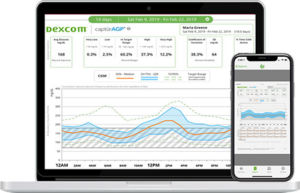

Healthy living is a hobby of mine, you might say. I’m not a master by any means, but I enjoy learning about it and experimenting.
My twenties weren’t quite as health focused. When I first got sober, I leaned into ice cream and kept a steady supply of Skittles and diet soda on hand. After I got my bearings, I saw a great opportunity – by waking up consistently hangover-free, I could really lean into health and wellness; a world that had always been so enticing, but so out of reach. Over time, I started eating – are you sitting down – vegetables. Regularly. As in, every day. My taste buds adjusted to the bitterness of kale. A doctor recommended I give up dairy and gluten. When I (finally) did, my body acne (sorry) and bloating and asthma vanished.
You could say I got cocky. I never stopped craving sweets, but I replaced the Skittles. Swapped Reese’s peanut butter cups for Justin’s dark chocolate peanut butter cups because I was so healthy. I focused on fiber. I drank tons of water. Did I continue to eat a lot of guac and chips? I did. (I do.)
But at 42, I feel reasonably comfortable proclaiming that yes, I am healthier than my 22-year-old self.
So, imagine my surprise when my blood work came back this spring with my hemoglobin A1C a point away from pre-diabetic ranges.
Hema-what you say? I got you. According to the CDC’s website, the hemoglobin A1C test “is a simple blood test that measures your average blood sugar levels over the past 3 months. It’s one of the most commonly used tests to diagnose prediabetes and diabetes.”

I was both offended and alarmed. But when my nurse practitioner offered to put me on the Dexcom G6 Continuous Glucose Monitor (CGM) for a ten-day trial, I also got excited.
In all my reading and podcast listening, I’ve heard about CGMs for years. They are the hottest new device on the market, it seems. Per Dexcom’s website, the G6 is “a small wearable [that] continuously sends glucose readings to your smartphone – or Dexcom receiver – without fingersticks.” By continuously monitoring your glucose, you can track what foods make it spike and what foods keep it in steady, safe ranges. These devices are revealing that health is more individual than we’d previously thought. One person may thrive on lentils and oatmeal and mangos. Someone else may discover that mangos spike her blood sugar as much as Skittles.
That someone else is me.

The CDC tells me that “a fasting blood sugar level of 99 mg/dL or lower is normal, 100-125 mg/dL indicates you have prediabetes, and 126 mg/dL or higher indicates you have diabetes.” My healthcare provider recommended slightly lower ranges. In the ten days I tracked my glucose, I lived in those ranges only a handful of times for short periods of time.
The first four days, I ate my normal foods – including all my favorite snacks and treats. I wanted to know how they interacted with my body. I intended to do that for the entire ten days, but it revealed a constant rollercoaster of glucose spikes with every meal. No wonder I was constantly exhausted, reaching for anything to keep me from napping. Turns out my entire panoply of food choices were carbohydrates … which break down into sugar … and make it basically impossible to lower blood glucose. Up until this point, I’d paid no heed to talk of carbs. I rolled my eyes when people talked protein. But by day five, I cut out (most) carbs and added in protein and fat. I kept the veggies but not the fruit. My levels slowly, slowly, slowly started lowering. In six months, if there’s another free 10-day trial available at the doctor’s office, I’ll check in again.
Why aren’t CGMs more widely available? My high glucose doesn’t just lead to pre-diabetes … it leads to “developing type 2 diabetes, heart disease, and stroke.” And a host of other issues. The good news? It’s preventable. What if we could learn what works for our individual bodies, adjust, and avoid these diseases altogether? Unfortunately, CGMs are cost-prohibitive to most Americans (me included). Even for some diabetic patients, according to my nurse practitioner, insurance won’t cover it.
When did health become so complicated? And why? It’s not just sorting through the mathematical equations of net carbs. It’s not just learning to understand labels. It’s the sheer volume of diabolically opposed claims from seasoned and highly qualified professionals that proclaim with great certainty that their way is the right way.
When health and wellness are one’s hobby, I’m here to tell you, life gets murky. Did I lean into comfort foods this past winter more often than I realized? I did. But also: every “health” food I loved was basically a carb party, and I just didn’t know until I started paying attention. At the end of the trial, I scrolled social media and unfollowed all my fave healthy living handles. I’ve unsubscribed to my (formerly fave) wellness website’s daily emails. I roll my eyes at headlines that promise oatmeal will put you on the path to wellness. I mean, maybe for some people? But let’s stop casting such a wide net.
Is my body STILL adjusting (read: am I craving sweets)? Yep. Do I have my grumpy moments because of it? Definitively yes. Will I occasionally have my old guac and chips standby? Affirmative. Do I think my body will improve, and maybe – just maybe – diabetes won’t be part of my story? Fingers crossed.
Maura Malloy is a writer, teacher and one-time TedX Talker. She is not a medical professional. The thoughts she shares in this article are hers, and hers alone.
All of our content—including this article—is completely free. However, we’d love if you would please consider supporting our journalism with an Indy Maven membership.









